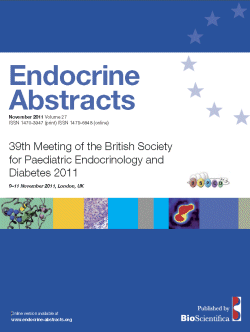
39th Meeting of the British Society for Paediatric Endocrinology and Diabetes
Oral Communications
Oral Communications 2 (Quick Fire)
ea0027oc2.1 | Oral Communications 2 (Quick Fire) | BSPED2011
Sperm cryopreservation in adolescent minors with cancer: factors predicting pre-treatment semen quality in 79 minors aged 12–18 years over 10 years
Gan Hoong Wei , Williamson Elizabeth , Davies Melanie , Spoudeas Helen
ea0027oc2.2 | Oral Communications 2 (Quick Fire) | BSPED2011
The assessment of bone microarchitecture by high resolution magnetic resonance imaging (micro MRI) in young adults with childhood onset disease
Yacoubian Calum , McComb Christie , Leddy Christopher , Ahmed Faisal , Foster John
ea0027oc2.3 | Oral Communications 2 (Quick Fire) | BSPED2011
MCM4 mutation causes a novel DNA replication disorder associated with short stature and adrenal failure
Hughes Claire , Guasti Leonardo , Meimaridou Eirini , Chaung Chen-Hua , Schimenti John , King Peter , Costigan Colm , Clark Adrian , Metherell Louise
ea0027oc2.4 | Oral Communications 2 (Quick Fire) | BSPED2011
Short term effects of recombinant IGF1 therapy in children with Laron's syndrome
Amin Nadia , Alvi Sabah , Walker Jenny , Whitehead Amanda , Mushtaq Talat
ea0027oc2.5 | Oral Communications 2 (Quick Fire) | BSPED2011
A selective effect of IGFBP3 on brain volumes in healthy children
Webb Emma , Clayden Jon , Edmonds C J , Seunarine K , Singhal A , Lanigan J , Lucas A , Clark C , Isaacs E , Dattani M T
ea0027oc2.6 | Oral Communications 2 (Quick Fire) | BSPED2011
What defines vitamin D deficiency biochemically in children?
Atapattu Navoda , Shaw Nicholas , Davies Paul , Hogler Wolfgang
ea0027oc2.7 | Oral Communications 2 (Quick Fire) | BSPED2011
Selective reduction in trabecular bone mineral density during treatment for childhood acute lymphoblastic leukaemia
Sands Rebecca , Moon Rebecca , Doherty Lianne , Kohler Jan , Davies Justin
ea0027oc2.8 | Oral Communications 2 (Quick Fire) | BSPED2011
Novel SOX2 mutation: from clinical phenotype to identification of new molecular mechanisms of SOX2 action and interactions
Alatzoglou Kyriaki S , Andoniadou Cynthia L , Kelberman Daniel , Kim Hyoong-Goo , Pedersen-White Jennifer , Layman Lawrence , Martinez-Barbera Juan Pedro , Dattani Mehul T



